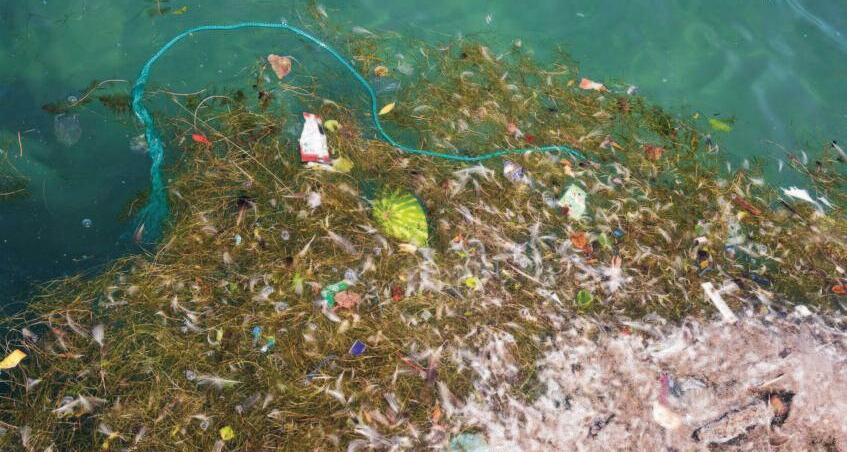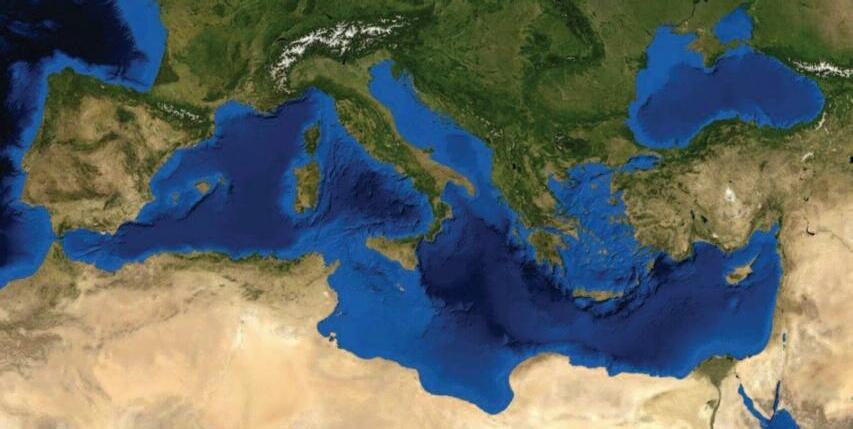
9 minute read
John Cornwell
Fate of “ our sea ” : climate change and the Mediterranean
John Cornwell
Advertisement
My interest in the state of the Mediterranean, subject of our April 2022 Science & Human Dimension Project workshop, and scheduled conference series for 2023 (see SHDP Report on pages 78-81), was originally roused by an environmental disaster 4,500 miles from the Mediterranean – in North America. Some years ago, flying down towards Toronto airport, I had a view from the aircraft window over Ontario ’ s great lake, shimmering blue and silver with stretches of golden beaches. In the afternoon fall light the scene was reminiscent of a Mediterranean seascape and beaches. How fortunate, I thought, for the millions of Americans and Canadians living within the watershed of the lake and its 700-mile shoreline shared by the province of Ontario and upstate New York. Yet I was soon to discover that the lake was contaminated. More disturbing, scientists were drawing parallels between the afflicted Great Lakes and the future of the Mediterranean.
I was due to lead a series of classes on Samuel Taylor Coleridge at McMaster University. Lake poet and one of the earliest eco-ethicists in the English language, Coleridge was convinced that unspoilt lakes and rural landscapes promote happiness and wellbeing. Coleridge and fellow Lake poet William Wordsworth published a manifesto (Preface to the Lyrical Ballads) arguing that creativity and human flourishing thrive when human passions “ are incorporated with the beautiful and permanent forms of nature ” . Coleridge influenced the poet and public intellectual Ralph Waldo Emerson, who in turn inspired Henry David Thoreau, whose book Nature celebrates the beneficence of American wildernesses; the importance of their preservation for future generations.
“It is the marriage of the soul with nature, ” Thoreau wrote, “that makes the intellect fruitful, and gives birth to imagination ” .
I was looking forward to exploring Ontario ’ s “beautiful and permanent forms of nature ” ; the ancient woodlands of the Niagara Escarpment, the scores of waterfalls and streams amidst glades of native trees; the islands and lagoons where the lake meets the mighty St Lawrence River; the magnificence of Niagara Falls some forty miles south of Hamilton. Yet the scenic beauty and apparent wilderness belied extensive pollution. The lake and its sister Great Lakes, comprising 20 per cent of the planet’ s fresh water, were in a poor state. Lake Erie had already been pronounced “dead” . Swimming was dangerous in Lake Ontario; what remained of the fish uneatable. I had a view from my lodgings over the “The Bay ” , an inlet from the lake; the surface was obscured by a thick layer of yellow and green sludge giving off a stench like garlic and rotting fish, a consequence of run-offs from local industries.
The origins of Lake Ontario tell a dramatic geological story. The basin was carved by an Ice Age glacier displacing a land mass that was pushed south, piling up in central and western presentday state of New York. When the glacier retreated, the lake drained into the Mohawk River; the glacier melted from the St Lawrence valley, leaving the outlet below sea level. For a time, the lake became a bay of the Atlantic until the land reasserted itself. The lakebed to this day tilts southward, causing erosion and inundations along the southern New York shoreline.
Pollution on Lake Ontario
Through the 17th and 18th centuries, the lake became a scene of trading operations and French missionary activity bringing conflict, disease and the decimation of indigenous peoples. The nation known as Wyandots, settled on the shores of Lake Huron, were reduced from 20,000 to some 600 in the course of 50 years. After the American Revolution dealings between the British and Americans settled into fruitful commerce. The Great Lakes were destined by the 20th century to become the most integrated and expanding commercial hub in the world, based on prolific waterway access including the building of the Erie Canal connecting the Atlantic with the Great Lakes. Cargo shipping saw the growth of industries amidst expanding populations. The region, embracing eight US states and two Canadian provinces, became home to automobile giants –Ford, General Motors, and Chrysler on the US side; mining, agriculture, logging, steel production on the Canadian. Lake Erie with the growth of its neighbouring cities and populations, some 12 million inhabitants by the 1960s, was polluted by shoreline heavy industries and intensive farming within the watersheds involving mass run-offs of fertilizers and pesticides. The lake was a dump for acids, oil spills, car batteries, truck and car wrecks.
At McMaster, a Lake Biologist led a series of evening seminars on the Great Lakes for people in the humanities. He spoke of phosphates, ammonia, cyanide and phenols in the waters; and eutrophication – an increase of nutrients causing harmful blooms of algae creating dead zones and the mass death of fish. One evening he surprised us by digressing to talk about the Mediterranean Sea, far larger than any of the lakes – 2,500 miles in length, east to west, 500 miles wide at its greatest distance, north to south – approximately 970,000 square miles, and up to three miles deep. Yet the Mediterranean, he explained, is like the Great Lakes, a virtually enclosed sea, renewed mainly by the flow of water eastwards from the Atlantic across the ocean-bed sills in the approach to the Strait of Gibraltar. Another source of replenishment comes from rivers, many of which are polluted. The Atlantic current forms an upper layer of water; the lower, flowing westward, known as the Mediterranean Outflow, is slower, heavier and saltier. The incoming waters from the Atlantic flow in anti-clockwise currents, taking some 80 years to arrive back at their departure point. He spoke of over-fishing, the dumping of petrochemicals, the dirty
refining of oil in the sea; eutrophication; and of climate change. He outlined the theoretical history of the geology of the Strait of Gibraltar and its profound significance for Mediterranean. Once an inlet of the Atlantic, the basin forming the Mediterranean Sea ran dry six million years ago as a massive tectonic event sealed off the inward flow from the mightier ocean. Scientists were modelling what might have occurred. After the Atlantic ceased to flow into the basin it became a massive dust and salt desert with mountain ranges and deep ravines. The basin remained in this condition for some 700,000 years until the natural dyke fractured once more. The Atlantic roared over the rim into the desert basin, the sea level rising at a rate of 30 feet a day.
Given the cultural perspectives on nature and the environment I was discussing in my classes on Coleridge, the notion of ‘ climate ’ addressed a wider significance than the preoccupations of scientific measurements and modelling. The prospective death of the Mediterranean struck me as an event fraught with tangible and imaginative significance for the hundreds of millions who inhabit those regions; tragic beyond words for all who recognise the Mediterranean as a homeland of the body, mind and spirit. As early as 1985, Sir David Attenborough reiterated at a conference in Rome what the celebrated French oceanographer Jacques Cousteau had forewarned in 1972: “By the early 1970s it was clear that the Mediterranean was dying ” . 1 Today, scientists are arguing that the sea, known in Ancient Rome as “Our Sea ” , forms a microcosm in which the environmental future of the planet is being played out in advance. It is the canary in the climate mine. Observing the fate of the Mediterranean enables us to see into the future state of the planet, and how the world at large is likely to respond. Unlike other tipping points across the globe – melting polar glaciers, inundated Pacific islands, vast Baltic ‘dead zones ’ – the Mediterranean is a complex, highly populated meeting point of diverse histories, ecologies and climates hospitable and harsh; the cradle of civilizations, the crucible of cultural heritages, the holy places of the religions of the Book. Bordered by 21 countries, with collective populations of 540 million and 300 million annual visitors, the Mediterranean is a wealthy industrial, agricultural and marine powerhouse, albeit marked by striking inequalities, geopolitical and humanitarian crises. The Mediterranean is representative in many senses of the planet at large. The 2020 1st Report on Climate and Environmental Change in the Mediterranean Basin declared the region the “ main hotspot in the world” , warming up 20 per cent faster than the global average. Some 250 million of its peoples are projected to be “ water poor ” within 20 years. Temperatures are expected to increase by 2.2°C (compared to pre-industrial level) by 2040. NASA’ s Goddard Institute for Space Studies found that the current drought that began in 1998 in the eastern Mediterranean, appears to be the worst of the past 900 years.
In September 2021, a meeting of EU heads of state in Athens were told that the city (with a history of human presence originating between the 11th and 7th millennia BC), was destined to become the world’ s first uninhabitable capital. As temperatures reached an unprecedented 47.1°C (116.8°F) that July, vast areas of farmland and forests were plagued by wildfires, prompting mass evacuations. Scientists calculate that sea temperatures could rise by 3.5°C by 2100, increasing salinity and density to unprecedented levels, while the sea could rise by 2.5 metres putting at risk the habitations of the 20 million people that live below the current 5 metres above sea level.
2
Researchers across the Mediterranean continue to monitor and model climate

The Mediterranean
change and associated environmental woes due to human activity: including carbon emissions, plastics and petrochemical pollution; overfishing, deforestation – with knock-on consequences: unseasonal intense heatwaves, proliferating wildfires, water contamination, marine eutrophication, flash floods. The social, economic and political consequences are already evident: water and food insecurity, refugee and migration crises, terrorism, heightened tension, armed conflict. Constituencies of Scientists, Social Scientists, and Policy Makers, hold regular meetings with law makers aimed at international collaboration. Collective decisions are hampered by short-termism, piece-meal strategies, ideological divides, and the sheer magnitude of the problems.
Archaeologists and Climate Historians have recorded the many environmental impacts on Mediterranean societies down the centuries, including volcanoes, earthquakes, drought, plague – from the Late Bronze Age and Antiquity to the late medieval Little Ice Age; from the Industrial Revolution to our fossil-fuelled polluted era of high growth technologies and rapidly expanding populations. Can the past come to the aid of the future? A profound imaginative and moral shock at the prospect of a devastated Mediterranean may yet provide impetus for radical action needed to save the planet at large. By the same token, reflections on historic catastrophes may offer grim reassurances of resilience, adaptation, and survival. And yet, the consideration –“this too will pass ” , a consolation for stoics down the millennia, offers scant philosophical comfort in the face of irreversible ruin.
If the peoples and governments of the Mediterranean cannot halt the slide to environmental disaster in their own limited habitat, what hope for the rest of the planet? On the other hand, the shock of the loss of “Our Sea ” , as the people of Ancient Rome called it, an epochal transgression against nature, may constitute a desperate yet salutary advantage despite the local catastrophic consequences. It may take the death of the Mediterranean to prompt the world into late, combined action to save what is left. n
References
1 David Attenborough, BBC TV documentary First Eden, 1985. 2 First Mediterranean Assessment Report. Union for Mediterranean Plan Bleu. UNEP/MAP, 2020.










